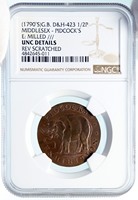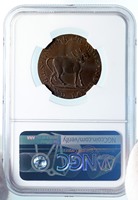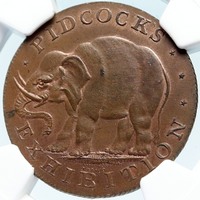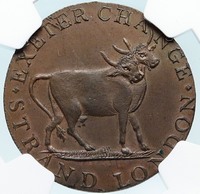England - Middlesex - Piccock's / Exeter Change - Conder Token
1795-1800 Copper Half-Penny Conder Token 28.86mm
Reference: D&H 423
Certification: NGC UNC DETAILS 4842645-011
* PIDCOCK'S * * EXHIBITION, Elephant standing left.
EXETER CHANGE STRAND LONDON, Two-headed cow right.
Coin Notes:
Coin was minted advertising Pidcock's exhibition of living animals at the Exeter Change, Strand, London, England. You are bidding on the exact item pictured, provided with a Certificate of Authenticity and Lifetime Guarantee of Authenticity.
_(14779040314).jpg/250px-Fifty_years_ago_(1888)_(14779040314).jpg) The Exeter Exchange (popularly known as Exeter Change) was a building on the north side of the Strand in London, with an arcade extending partway across the carriageway. It is most famous for the menagerie that occupied its upper floors for over 50 years, from 1773 until it was demolished in 1829. The Exeter Exchange (popularly known as Exeter Change) was a building on the north side of the Strand in London, with an arcade extending partway across the carriageway. It is most famous for the menagerie that occupied its upper floors for over 50 years, from 1773 until it was demolished in 1829.
Exeter Exchange was built in 1676, on the site of the demolished Exeter House (formerly Burghley House and Cecil House), London residence of the Earls of Exeter, almost opposite the Savoy Hotel. Around the same time, the nearby Burleigh Street and Exeter Street were laid out. The Exeter Exchange originally housed small shops (milliners, drapers, hosiers) on the ground floor, and rooms above which were let to the Land Bank. Over time, the traders on the ground floor were replaced by offices, and the upper rooms were used for storage. The management began to re-purpose to upper rooms. In April 1770, Giovanni Battista Gervasio, an Italian mandolinist who traveled Europe, gave a concert in "the room over the Exeter Exchange."[1] It was the first time it had been used for that purpose. From 1773, the upper rooms were let to a series of impresarios who operated a menagerie in competition with the Royal Menagerie at the Tower of London. The menagerie at the Exeter Exchange at various times included lions, tigers, monkeys, and other exotic species, all confined in iron cages in small rooms. The roaring of the big cats could be heard in the street below, occasionally scaring horses that passed by. The menagerie was established by Thomas Clark but was purchased in 1793 by Gilbert Pidcock. It subsequently passed into the ownership of Stephani Polito. Both Pidcock and Polito were operators of travelling circuses, who used the Exeter Exchange as winter quarters for their animals. The menagerie was a popular visitor attraction. It was visited by Wordsworth and Byron; artists such as Edwin Landseer and Jacques-Laurent Agasse painted the animals. Polito died in 1814, and the menagerie was acquired by one of his former employees, Edward Cross. Cross renamed the collection the Royal Grand National Menagerie, and employed a doorkeeper who was dressed as a Yeoman of the Guard. His bad-tempered elephant, Chunee, was shot there in March 1826 by soldiers from Somerset House. When the Exeter Exchange was demolished in 1829, as part of general improvements to the Strand, the animals were dispersed to the new London Zoo in Regent's Park and Cross's new enterprise at Surrey Zoological Gardens. Exeter Hall was built on the site, opening in 1831 and surviving until 1907. The site is now occupied by the Strand Palace Hotel.
 Middlesex (abbreviation: Middx) is an historic county in southeast England. It is now entirely within the wider urbanised area of London. Its area is now also mostly within the ceremonial county of Greater London, with small sections in other neighbouring ceremonial counties. It was established in the Anglo-Saxon system from the territory of the Middle Saxons, and existed as an official unit until 1965. The historic county includes land stretching north of the River Thames from 3 miles (5 km) east to 17 miles (27 km) west of the City of London with the rivers Colne and Lea and a ridge of hills as the other boundaries. The largely low-lying county, dominated by clay in its north and alluvium on gravel in its south, was the second smallest county by area in 1831. Middlesex (abbreviation: Middx) is an historic county in southeast England. It is now entirely within the wider urbanised area of London. Its area is now also mostly within the ceremonial county of Greater London, with small sections in other neighbouring ceremonial counties. It was established in the Anglo-Saxon system from the territory of the Middle Saxons, and existed as an official unit until 1965. The historic county includes land stretching north of the River Thames from 3 miles (5 km) east to 17 miles (27 km) west of the City of London with the rivers Colne and Lea and a ridge of hills as the other boundaries. The largely low-lying county, dominated by clay in its north and alluvium on gravel in its south, was the second smallest county by area in 1831.
The City of London was a county in its own right from the 12th century and was able to exert political control over Middlesex. Westminster Abbey dominated most of the early financial, judicial and ecclesiastical aspects of the county. As London grew into Middlesex, the Corporation of London resisted attempts to expand the city boundaries into the county, which posed problems for the administration of local government and justice. In the 18th and 19th centuries the population density was especially high in the southeast of the county, including the East End and West End of London. From 1855 the southeast was administered, with sections of Kent and Surrey, as part of the area of the Metropolitan Board of Works. When county councils were introduced in England in 1889 about 20% of the area of Middlesex, along with a third of its population, was transferred to the new County of London and the remainder became an administrative county governed by the Middlesex County Council[6] that met regularly at the Middlesex Guildhall in Westminster, in the County of London. The City of London, and Middlesex, became separate counties for other purposes and Middlesex regained the right to appoint its own sheriff, lost in 1199.  In the interwar years suburban London expanded further, with improvement and expansion of public transport, and the setting up of new industries. After the Second World War, the population of the County of London and inner Middlesex was in steady decline, with high population growth continuing in the outer parts. After a Royal Commission on Local Government in Greater London, almost all of the original area was incorporated into an enlarged Greater London in 1965, with the rest transferred to neighbouring counties. Since 1965 various areas called Middlesex have been used for cricket and other sports. Middlesex was the former postal county of 25 post towns. In the interwar years suburban London expanded further, with improvement and expansion of public transport, and the setting up of new industries. After the Second World War, the population of the County of London and inner Middlesex was in steady decline, with high population growth continuing in the outer parts. After a Royal Commission on Local Government in Greater London, almost all of the original area was incorporated into an enlarged Greater London in 1965, with the rest transferred to neighbouring counties. Since 1965 various areas called Middlesex have been used for cricket and other sports. Middlesex was the former postal county of 25 post towns.
Conder Tokens, also known as 18th Century Provincial Tokens, are a form of privately minted token coinage struck and used during the latter part of the 18th Century and the early part of the 19th Century in England, Anglesey and Wales, Scotland, and Ireland. The driving force behind the need for token coinage was the shortage of small denomination coins for everyday transactions. However, the demand was fueled by other factors such as the Industrial Revolution, population growth, and the preponderance of counterfeit circulating coins. Because the government made little effort to ameliorate this shortage, private business owners and merchants took matters into their own hands, and the first tokens of this type were issued in 1787 to pay workers at the Parys Mine Company. By 1795, millions of tokens of a few thousand varying designs had been struck and were in common use throughout Great Britain. Collecting Conder tokens has been popular since shortly after they were first manufactured, resulting in the availability today of many highly preserved examples for collectors. The demarcation of what is or is not considered a Conder token is somewhat unclear; however, most collectors consider Conder tokens to include those indexed originally by James Conder or later by Dalton & Hamer.
|




_(14779040314).jpg/250px-Fifty_years_ago_(1888)_(14779040314).jpg) The Exeter Exchange (popularly known as Exeter Change) was a building on the north side of the Strand in London, with an arcade extending partway across the carriageway. It is most famous for the menagerie that occupied its upper floors for over 50 years, from 1773 until it was demolished in 1829.
The Exeter Exchange (popularly known as Exeter Change) was a building on the north side of the Strand in London, with an arcade extending partway across the carriageway. It is most famous for the menagerie that occupied its upper floors for over 50 years, from 1773 until it was demolished in 1829.  Middlesex (abbreviation: Middx) is an historic county in southeast England. It is now entirely within the wider urbanised area of London. Its area is now also mostly within the ceremonial county of Greater London, with small sections in other neighbouring ceremonial counties. It was established in the Anglo-Saxon system from the territory of the Middle Saxons, and existed as an official unit until 1965. The historic county includes land stretching north of the River Thames from 3 miles (5 km) east to 17 miles (27 km) west of the City of London with the rivers Colne and Lea and a ridge of hills as the other boundaries. The largely low-lying county, dominated by clay in its north and alluvium on gravel in its south, was the second smallest county by area in 1831.
Middlesex (abbreviation: Middx) is an historic county in southeast England. It is now entirely within the wider urbanised area of London. Its area is now also mostly within the ceremonial county of Greater London, with small sections in other neighbouring ceremonial counties. It was established in the Anglo-Saxon system from the territory of the Middle Saxons, and existed as an official unit until 1965. The historic county includes land stretching north of the River Thames from 3 miles (5 km) east to 17 miles (27 km) west of the City of London with the rivers Colne and Lea and a ridge of hills as the other boundaries. The largely low-lying county, dominated by clay in its north and alluvium on gravel in its south, was the second smallest county by area in 1831.  In the interwar years suburban London expanded further, with improvement and expansion of public transport, and the setting up of new industries. After the Second World War, the population of the County of London and inner Middlesex was in steady decline, with high population growth continuing in the outer parts. After a Royal Commission on Local Government in Greater London, almost all of the original area was incorporated into an enlarged Greater London in 1965, with the rest transferred to neighbouring counties. Since 1965 various areas called Middlesex have been used for cricket and other sports. Middlesex was the former postal county of 25 post towns.
In the interwar years suburban London expanded further, with improvement and expansion of public transport, and the setting up of new industries. After the Second World War, the population of the County of London and inner Middlesex was in steady decline, with high population growth continuing in the outer parts. After a Royal Commission on Local Government in Greater London, almost all of the original area was incorporated into an enlarged Greater London in 1965, with the rest transferred to neighbouring counties. Since 1965 various areas called Middlesex have been used for cricket and other sports. Middlesex was the former postal county of 25 post towns. 
